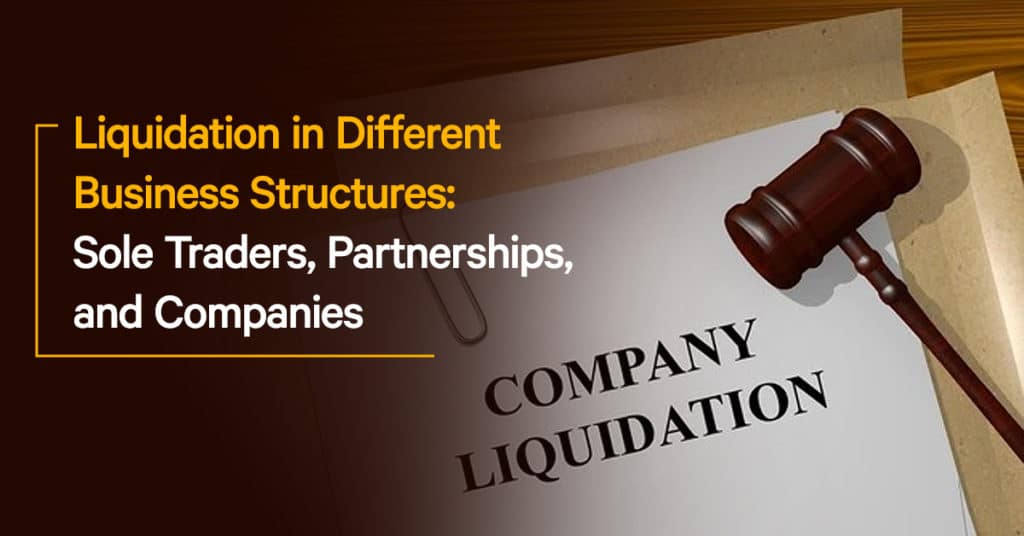The liquidation process is a critical aspect of insolvency proceedings and can vary depending on the business structure in question. The three primary business structures – sole traders, partnerships, and companies – face unique challenges and procedures when navigating liquidation. This blog post aims to explain the subtle differences of liquidation in different business structures, providing valuable insights for entrepreneurs and business owners to make informed decisions, preparing them for the complexities of liquidation processes, and highlighting the importance of strategic financial planning tailored to their specific business model. It delves into how these structures influence the extent of financial and legal responsibilities, the risks involved, and the overall impact on stakeholders.
Liquidation in Sole Traders
Sole traders are individuals who own and run their businesses alone. With this structure, there’s no legal distinction between the owner and the business. This means that, during liquidation, personal assets can be at risk. The liquidation process for sole traders typically involves ceasing operations and selling off business and personal assets to repay creditors. This process, which is often less complex than corporate liquidation, does not require formal insolvency procedures. However, sole traders may opt for bankruptcy as a form of liquidation, where they hand over their assets and, in return, get most debts written off.
Liquidation in Partnerships
Partnerships involve two or more individuals or entities running a business. Similar to sole traders, partners in traditional partnerships face personal liability for business debts. The liquidation process here is more complicated, as it must account for the interests and assets of multiple individuals. Partnerships may go through a process known as ‘partnership voluntary arrangement’ (PVA) or ‘partnership liquidation’. A PVA allows the partnership to continue trading while paying off debts. In contrast, partnership liquidation involves selling off assets to pay creditors, often leading to the end of the partnership.
Liquidation in Companies
Companies, being separate legal entities from their owners, face a more complex liquidation process. The two main types of company liquidation are ‘Creditors’ Voluntary Liquidation’ (CVL) and ‘Compulsory Liquidation’. In a CVL, the company directors voluntarily decide to liquidate after concluding that the company can’t pay its debts. Compulsory liquidation, on the other hand, is typically initiated by creditors through a court process. In both cases, a licensed insolvency practitioner takes charge, liquidating assets to pay off creditors as much as possible. Shareholders may receive any remaining funds, but this is rare, as creditors take priority.
Impact of Business Structure on Liquidation
The impact of liquidation varies greatly depending on the business structure. For sole traders and partners in a partnership, personal financial stability is directly tied to the business’ fortunes. This means personal assets, including homes, can be at risk. In comparison, company directors generally do not face personal liability unless they’ve given personal guarantees or are found guilty of wrongful trading.
In the context of liquidation, the implications extend beyond mere financial losses. For sole traders and partners, the blurring lines between personal and business finances often lead to significant stress and uncertainty, impacting their financial health and their well-being. Also, the reputational impact can be more pronounced for individuals, as their business is closely associated with their personal identity. On the other hand, company directors, while protected to some extent from personal liability, must navigate corporate governance and regulatory compliance. Failure to adhere to these can result in serious legal consequences beyond the scope of financial loss. Understanding these varied impacts is important for entrepreneurs and business owners to make informed decisions about their business structure and prepare for any potential financial challenges.
Navigating Liquidation
Navigating liquidation in different business structures requires careful consideration of various legal and financial factors. For sole traders and partnerships, assessing personal asset exposure and seeking personal insolvency advice is important. Companies, meanwhile, must engage with licensed insolvency practitioners. In all cases, early intervention and professional advice can lead to better outcomes, potentially avoiding liquidation through alternative arrangements like company voluntary arrangements or administration.
This process also involves understanding the implications for employees, creditors, and other stakeholders. Navigating the tax implications and ensuring compliance with regulatory requirements are important elements of the liquidation process. Understanding this not only helps in managing the immediate challenges of liquidation but also in planning for a sustainable financial future post-liquidation. Business owners must stay informed and proactive to navigate these challenging waters with minimal disruption.
Why Understanding Liquidation in Different Business Structures Matters
Understanding liquidation in different business structures is essential for entrepreneurs and business owners. Each structure presents unique challenges and protections in the face of financial distress. Sole traders and partners in traditional partnerships must be mindful of personal liability while company directors navigate a more complex, although less personally risky, liquidation process. Professional advice and early intervention are key to managing these challenges effectively. The journey through liquidation in different business structures is undoubtedly complex but, with the correct guidance and strategy, can be navigated successfully.
It’s also important to understand the emotional and psychological impact of liquidation. The process can be stressful and may affect decision-making. A support system, including legal and financial advisors, can provide much-needed clarity and reassurance. Learning from the liquidation process can offer valuable insights for future business ventures, highlighting the importance of robust financial planning and risk management in any business.
Take the Next Step Towards a Tailored Insolvency Solution
Navigating liquidation requires expert guidance tailored to your unique situation. Our team of qualified and knowledgeable insolvency practitioners are here to provide you with the best insolvency solutions. Each of our practitioners is authorised by the Institute of Chartered Accountants in England and Wales, ensuring you receive top-tier, impartial advice. We are committed to guiding you through the process of liquidating your business most cost-effectively. Reach out to us for a consultation that could reshape your financial future. Use our live chat, email us at mail@Simpleliquidation.co.uk, or call us on 0800 246 5895.




